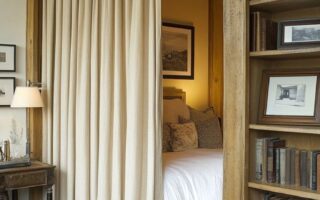“Floral perfumes don’t only go with floral outfits, but if you’re aiming for a perfect match, then yes—floral on floral is unbeatable. Why? Because perfume isn’t just a scent; it’s part of the full look, the aura you give off. A floral dress already signals softness, elegance, or even bold romance, depending on the print. Pair that with a floral scent, and you’re not just wearing an outfit—you’re creating a full sensory experience. It’s cohesive, intentional, and elevated.
Wearing floral perfume with something like a leather jacket or a sharp blazer? It can still work, but there’s a disconnect. The outfit says edgy, structured, or sleek, while the scent is whispering of blooming gardens and soft femininity. It’s a contrast—sometimes intriguing, but not seamless. If you want an effortlessly harmonious vibe, floral perfumes belong with floral outfits. It’s the difference between looking well-dressed and looking like the whole aesthetic was custom-curated down to the last detail.”
In this article
SOME DAYS …
I wake up determined to have a productive morning, but fate usually has other plans. Step one: skincare. Step two: pick an outfit. Step three: descend into absolute chaos.
I stand before my closet, a wise philosopher staring into the abyss. After a dramatic struggle (and two existential crises), I finally settle on the outfit—sunny, sassy, a masterpiece of streetstyle Diani in the middle of June. Victory? Ha. The real battle is just beginning.
Perfume.
I reach for my floral bottle, but—wait. Too soft. This outfit demands chill. Maybe the deep, spicy oud? No, too much—people will think I’m closing billion-dollar deals before 9 AM. Citrus? Too fresh. Musk? Too moody. Vanilla? Am I trying to smell like a bakery?
Suddenly, I’m pacing, testing, overthinking. The room now smells like Stall 63 at Maasai Market. I check the time—forty minutes lost to scent-induced delirium. Desperate, I grab my chai-kahawa, a little bit over the idea of showering and starting over. I do still consider calling in sick one more time…
…until in the end, I spritz on the eenie, meenie, miney, mo winner, sprint out the door, and accept that some battles in life are just unwinnable.
Why Is Choosing the Right Perfume for an Outfit So Difficult?
The challenge of picking the perfect perfume isn’t just about preference—it’s about alignment. Scent is an invisible accessory that interacts with an outfit’s colors, textures, and overall vibe.
While outfits visually communicate personality, intent, and mood, perfume reinforces or contradicts those messages on a subconscious level.
This difficulty arises from several factors.
Psychology
Perfume, like fashion, evokes emotions. The same way a red dress feels different from a beige one, a deep, spicy oud feels different from a fresh citrus.
But while we visually assess outfits immediately, perfume choices require imagination—How will this smell feel with what I’m wearing? That mental leap is where the struggle begins.
Amazing. I bet it never crossed your mind.
The first obstacle is psychological—more precisely, the challenge of visualizing scent in the context of what is seen.
Our brains are wired to assess visuals instantaneously; a glance at an outfit is enough to gauge its appropriateness for the occasion. But scent?
Scent is time-based, unfolding gradually, which means we must mentally simulate how a perfume will interact with our chosen look.
- A red dress is immediately registered as bold, but how does red smell? Spicy? Fruity? Musky? The answer is not straightforward because scent is not color.
- A crisp white outfit suggests freshness, but does that mean a white floral? A citrus? A clean musk? There is no universal rule, only interpretation.
This disconnect creates a gap in sensory alignment, requiring imagination, intuition, and sometimes pure trial and error. This is also why people default to habit—reaching for the same perfume every day eliminates the mental strain of making an uncertain choice.
💡 :
Train the brain to create stronger scent associations. For a week, pick out your perfume before picking out an outfit. Let the textures and colours you wear be inspired by the perfume instead.
This will require a little bit of extra organization on your part.
When you wake up, take a whif of the perfume of the day, and write down or voice record how the scent made you feel. What colours and emotions it evoked. Be completely honest, don’t force things.
This builds subconscious connections that make future pairings more instinctive.
The Complexity of Scent Profiles
Perfumes aren’t just “floral” or “woody.” They unfold in layers—top, heart, and base notes—that interact with body chemistry, weather, and even fabrics. A delicate, airy floral can turn sickly sweet in heat, while a rich, musky scent can feel suffocating in a lightweight linen outfit.
what you put on in the morning largely remains unchanged throughout the day. Perfume, however, lives, breathes, and evolves. It has a temporal structure:
- Top Notes: Immediate impression (often fresh, light, or sharp).
- Heart Notes: The main character of the fragrance, emerging after the top fades.
- Base Notes: The final, long-lasting impression that lingers hours later.
The difficulty? What you smell in the bottle is never exactly what you’ll smell after an hour.
You may think you’ve chosen a “fresh floral” to match a delicate pastel dress, only to realize later that the base note is an intense, sensual musk that clashes with the outfit’s intended softness.
Further complicating this is the interaction between perfume and environment:
- A perfume that smells airy in a cold room can feel overwhelmingly sweet in humid weather.
- A light citrus that fits a linen dress at noon can feel underwhelming when that same dress is worn for a candlelit dinner.
- Some scents cling to certain fabrics more intensely—woody notes hold onto wool differently than they do on silk.
💡 :
Think in time layers, not just in immediate impressions.
When selecting a perfume, ask: What will this smell like in 4 hours? How will it interact with the natural changes of my body temperature and the atmosphere?
Pairing scent with fabric is also crucial—consider heavier perfumes for structured materials and light scents for flowy fabrics to maintain olfactory-textural balance.
Outfit and Occasion Mismatch
A leather jacket with a sweet, powdery scent can feel off because leather suggests edge while powdery notes suggest softness. Similarly, a thick wool coat with a light summer floral can feel as disjointed as wearing sandals in the snow.
Every outfit carries implied personality traits, and perfume either strengthens or weakens those signals. The challenge arises when the two send contradictory messages.
Contradictions That Create Discomfort
- A powdery, delicate scent with a sharp leather jacket → The scent whispers innocence, but the jacket demands edge.
- A summer floral with a thick wool coat → Like wearing tropical sandals in winter—it creates a sensory mismatch.
- A deep oud with a minimalist white linen outfit → Too heavy for the light, effortless visual.
Why does this feel wrong?
Because humans process sensory information holistically.
If one element contradicts another, the brain registers an imbalance—even if the wearer doesn’t consciously recognize it.
This is the olfactory equivalent of an outfit looking mismatched even if all the individual pieces are stylish on their own.
💡 :
Think of perfume as a garment in itself.
Ask: If this perfume were an outfit, what would it look like? If the answer doesn’t match the actual outfit, reconsider.
The Paradox of Choice
If you own multiple perfumes, choosing one feels like locking yourself into an identity for the day.
The more options, the more doubt. The stakes?
Walking out smelling 10% off-brand from your own aesthetic, which can throw off confidence.
If you own multiple perfumes, choosing one is not just about scent—it’s about deciding who you are that day. The more options you have, the more fragmented your decision-making becomes.
Unlike clothing, which can be layered or adjusted throughout the day, perfume is more permanent—once applied, it lingers for hours, meaning the commitment feels higher. This creates decision paralysis because selecting the “wrong” perfume feels like setting yourself up for an identity crisis halfway through the day.
- If you pick a dark, sensual scent in the morning but later wish for something fresher, you’re stuck with it.
- If you choose a light citrus but realize midday that the day’s mood is more intense, your scent is now misaligned with your energy.
This is why people struggle with a feeling of finality when choosing perfume, while outfit changes feel more flexible. The stakes feel oddly high, leading to overthinking.
💡 :
Consider layering complementary scents or carrying a travel-sized neutralizer (like an unscented wipe) to adjust throughout the day.
This prevents the anxiety of being locked into one mood and allows a more fluid transition between scents as the day progresses.
How to decide on the right perfume for your outfit
The Cognitive and Sensory Science Behind Training the Brain to Decide on the Right Perfume for an Outfit
The idea of selecting perfume before choosing an outfit may seem counterintuitive at first, but when analyzed through neuroscience, sensory integration, and behavioral conditioning, it becomes an advanced method for refining instinctual decision-making.
The challenge of pairing fragrance with clothing stems from the immediate nature of visual assessment versus the abstract, evolving nature of scent.
Reversing the order results in you training your brain to bridge the sensory gap more effectively.
Below are three solidly reasoned, deeply analytical points validating why this method rewires your ability to instinctively decide on the right perfume for your outfit in the future.
1. Neurological Encoding: Strengthening the Brain’s Scent-Visual Memory Pathway
Our brains encode olfactory information differently than visual data.
Smell is processed in the limbic system, which governs emotion and memory, whereas visual input is handled in the occipital lobe and linked to immediate recognition and spatial processing.
This separation is precisely why people can describe an outfit in detail after seeing it but struggle to recall a scent unless they smell it again.
You force the brain to create a direct association between the two senses, building stronger neural pathways between smell and visual stimuli.
Over time, these connections solidify into instinctual recall, reducing the effort required to decide on the right perfume for your outfit.
Psychologists studying multi-sensory integration have found that pairing an unfamiliar stimulus (scent) with a familiar one (color, texture) strengthens memory retention.
After a week of deliberately making outfit choices after selecting perfume, you will start to automatically recall the visual aesthetics that match specific scents—even without thinking.
This means that in the future, instead of hesitating over perfume selection, your mind will autonomously match fragrance to attire, eliminating decision fatigue.
2. Emotional Mapping: Training the Subconscious to Categorize Scent Moods in Relation to Fashion
Every perfume carries an emotional signature, but most people don’t engage deeply enough with their fragrances to articulate it.
Instead, they rely on loose, general categories—floral scents feel “pretty,” woody scents feel “warm,” and citrus scents feel “fresh.”
This oversimplification is precisely why it’s difficult to decide on the right perfume for an outfit: the emotional dimensions of fragrance remain vague.
The act of journaling or voice-recording emotional responses to scent before dressing forces a higher level of engagement with each perfume’s psychological impact. It requires one to pinpoint:
- What exact feeling does this scent evoke? (Not just “fresh” but “like crisp morning air in the Alps”)
- What color does it mentally project? (Not just “yellow” but “pale gold with a silver shimmer”)
- What type of fabric does it suggest? (Not just “soft” but “silk that catches the light”)
Over time, this depth of analysis eliminates hesitation when matching fragrance to attire.
Instead of overthinking perfume selection, you will have already developed an internal catalog of scent-emotion-texture-color correspondences.
Eventually, deciding on the right perfume for your outfit becomes an automatic, subconscious process rather than an analytical struggle.
3. The Decision Reversal Principle: Breaking the Paradox of Choice to Enhance Perfume-Style Harmony
One of the biggest reasons people struggle to decide on the right perfume for an outfit is choice overload. When selecting a perfume last, it often feels like locking into an identity after an entire look has already been decided, which can trigger self-doubt and second-guessing. However, flipping the sequence—fragrance first, outfit second—introduces a principle of decision hierarchy that simplifies the process.
- When picking an outfit first, you leave perfume open-ended, making it feel like an overwhelming final stamp on the look.
- When picking perfume first, you set a thematic foundation, making outfit selection feel guided rather than arbitrary.
The Decision Reversal Principle is a behavioral strategy that reduces overthinking by eliminating the most cognitively demanding choice first.
It is often applied in business and strategic planning to prevent analysis paralysis, and it works just as effectively in personal style.
When you set the olfactory tone first, you don’t just decide on the right perfume for your outfit—you structure your entire dressing process with greater coherence and ease.
Takeaway
Fragrance should be your Pre-Set, Not an Afterthought
Most people view perfume as a last-minute addition, which is why it often feels disconnected from their overall look.
But when scent is chosen first, it pre-frames the aesthetic, making the outfit a response to an existing identity rather than a standalone decision.
Through neurological encoding, emotional mapping, and decision hierarchy restructuring, this method shifts perfume selection from a struggle into a seamless, instinctive extension of one’s style.
In other words? The more you practice dressing for your perfume, the less you’ll ever have to think twice about deciding on the right perfume for your outfit again.




